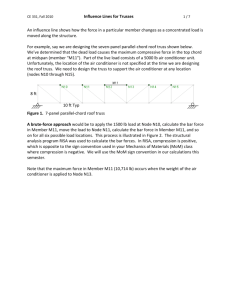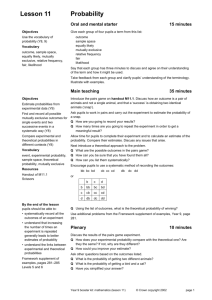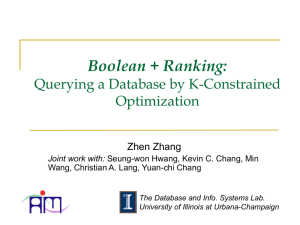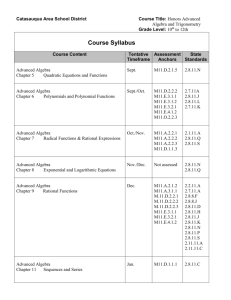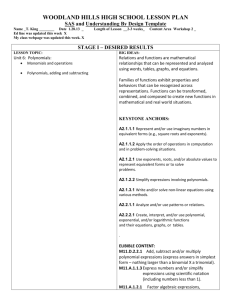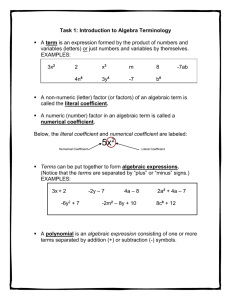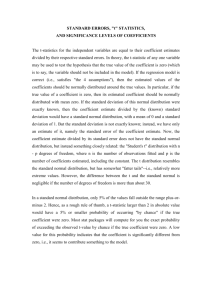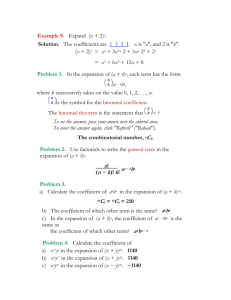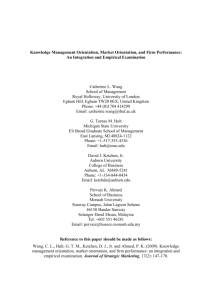A Numerical Exercise On Dynamical Budgeting Model
advertisement
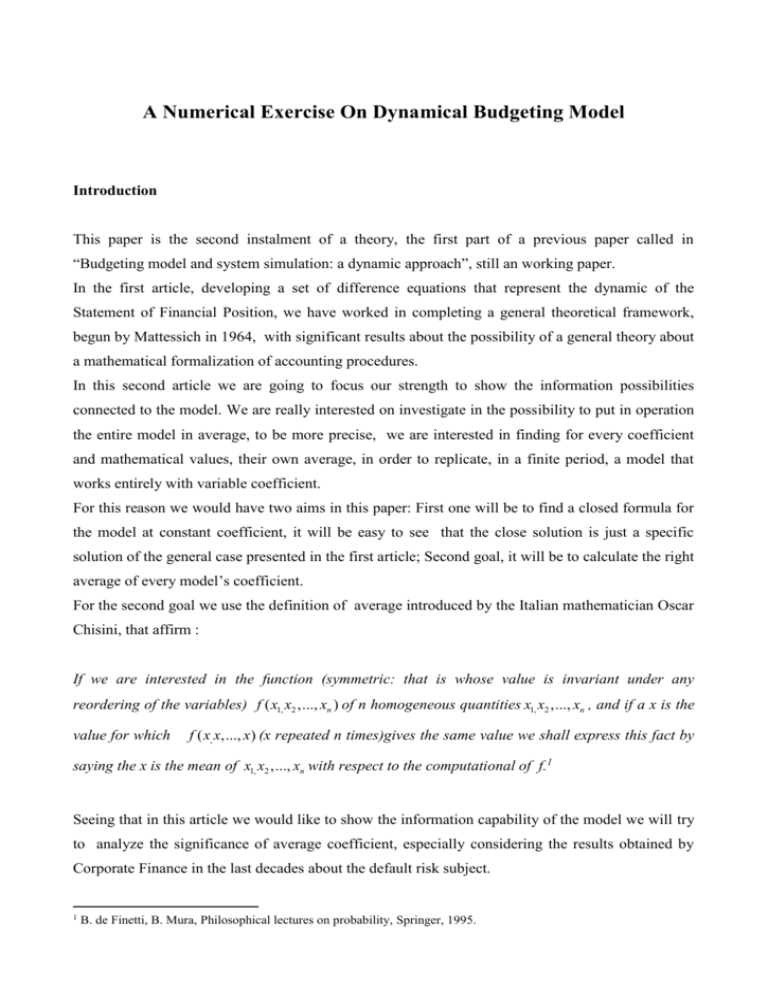
A Numerical Exercise On Dynamical Budgeting Model Introduction This paper is the second instalment of a theory, the first part of a previous paper called in “Budgeting model and system simulation: a dynamic approach”, still an working paper. In the first article, developing a set of difference equations that represent the dynamic of the Statement of Financial Position, we have worked in completing a general theoretical framework, begun by Mattessich in 1964, with significant results about the possibility of a general theory about a mathematical formalization of accounting procedures. In this second article we are going to focus our strength to show the information possibilities connected to the model. We are really interested on investigate in the possibility to put in operation the entire model in average, to be more precise, we are interested in finding for every coefficient and mathematical values, their own average, in order to replicate, in a finite period, a model that works entirely with variable coefficient. For this reason we would have two aims in this paper: First one will be to find a closed formula for the model at constant coefficient, it will be easy to see that the close solution is just a specific solution of the general case presented in the first article; Second goal, it will be to calculate the right average of every model’s coefficient. For the second goal we use the definition of average introduced by the Italian mathematician Oscar Chisini, that affirm : If we are interested in the function (symmetric: that is whose value is invariant under any reordering of the variables) f ( x1, x2 ,..., xn ) of n homogeneous quantities x1, x2 ,..., xn , and if a x is the value for which f ( x, x,..., x) (x repeated n times)gives the same value we shall express this fact by saying the x is the mean of x1, x2 ,..., xn with respect to the computational of f.1 Seeing that in this article we would like to show the information capability of the model we will try to analyze the significance of average coefficient, especially considering the results obtained by Corporate Finance in the last decades about the default risk subject. 1 B. de Finetti, B. Mura, Philosophical lectures on probability, Springer, 1995. Constant Close Formula First of all we have to write the set of equations again: S n M n ( S n 1 C ) F S0 S L( o ) C (o) R( o ) K(o) D( o ) Df ( o ) L( n ) (1 ) L( n 1) (C1( n 1) F ) K ( n 1) ( D1( n 1) G ) d Df ( n 1) m.r nF p / m C (1 ) (C ( n 1) F ) (n) Rn V1 R( n 1) V (Y ' Y ) K n (1 ) K ( n 1) An D( n ) (1 ) ( D1( n 1) G ) Df ( n ) D f ( n 1) m.r nF In this model a little modification have been done by the authors in order to achieve the possibility of finding a constant close formula and to calculate the average of every variable. The first modification is to write down every coefficient and every variable as a constant. In order to find a close solution for the model with constant parameters we are going to utilize the same logic construction we used it in the first paper; in fact, we are start analyze how the set of equation works in a matrix representation. SP(t) M SP(t) C 0 Ln 1 C 0 (1 ) 0 0 n Rn 0 0 V 0 = 0 0 (1 ) K n 0 Dn 0 0 0 0 0 0 0 Df n 0 d L( n 1) 0 0 C1( n 1) 0 0 R( n 1) + . 0 0 K ( n 1) D( n 1) (1 ) 0 1 Df ( n 1) 0 F (Y ' Y ) V 0 G 0 F m.r nF p / m 0 0 + A 0 m.r nF It is easy to show the dynamic of Balance Sheet as recursive sequence, with this form S1 =M(S0 CE )=M S0 M CE F S2 M S1 CE F M (M S0 M CE F CE ) F M 2 S0 M 2 CE M F CE F S3 M S2 CE F M ( M 2 S0 M 2 CE M F CE F CE ) F Using the induction principle the close solution is n 1 n Sn M S0 M CE M g F n l l 1 g 0 After n multiplication the matrix will have always this form m11 0 0 0 0 0 m12 0 m14 m15 m22 0 0 0 0 m33 0 0 0 0 m44 0 0 0 0 m55 0 0 0 0 m16 0 0 0 0 m66 n it's easy to prove the form will be M (1) M (2) .... M (h n) M M n . Thus our goal is to j 1 write down a mathematical expression for each element of matrix at time n. Multiplying the matrix M M thus you could analyze the evolution that every single elements m112 0 0 0 0 0 m212 m12 (m11 m22 ) ... ... ... 2 m22 0 0 0 0 2 33 m 0 0 2 44 0 0 m 0 0 0 0 2 m55 0 0 0 0 m 216 m16 (m11 m66 ) 0 0 0 0 2 m66 The elements of the diagonal have the same and simple evolution, thus, using mathematical induction we can prove that the m n ii element have the following shape: m n ii mn ii The elements of first row needs other considerations, but always using mathematical induction we give to them the following form: m 21 j m12 (m11 m22 ) m31 j m 211 m12 [m12 (m11 m22 )] m22 .... n m n1 j m1 j (m j11 m njj j ) j 0 Using the principle of induction it can be proved that for every matrix’s elements one have: n m n 1j m1 j (m 11 m j j 0 n j jj ) m1 j ( m11n1 mnjj1 m11 m jj ) Substituting in the previous formulas the elements of the matrix it will be possible to evaluate the first part of dynamic solution of the set, to be more precise the matrix diagonal So we can define for the diagonal: m n11 (1 ) n m n 22 (1 ) n m n 33 V n m n 44 (1 ) n m n 55 (1 ) n m n 66 1 M n S0 . Therefore you will have for and for the first row m n12 [ (1 ) n (1 ) n ] m n13 0 m n14 m n15 [ m n16 d [ [(1 ) n (1 ) n ] (1 ) n (1 ) n ] (1 ) n 1 ] The next step is to give a mathematical shape to the last part of the dynamic solution, namely. These n are M l CE and l 1 n 1 M g F . The close formulas of these parts are enough simple because this is g 0 nothing else than a summation of geometric series. For the first summation one have for every diagonal’s elements: 1 mn jj m jj m jj m m jj ( ) 1 m jj l 1 l 0 n 1 n l n jj And for the first row: n n m1 j l 1 l 1 m11 m jj m1 j l (m11n m njj ) m1 j m11 m jj n 1 n 1 l 0 l 0 (m11 m11n m jj m njj ) 1 m n jj 1 m n11 [m11 ( ) m jj ( )] m11 m jj 1 m11 1 m jj m1 j Thus for the first row we will have: s1 1 (1 ) n m n11 (1 )[ ] s1 1 (1 ) n m n 22 (1 )[ ] 1V n m n 33 V [ ] 1V 1 (1 ) n s1 n m 44 (1 )[ ] s1 s1 s1 m n m n 55 1 (1 ) n (1 )[ ] 66 n For the first row one will have: s1 s1 m n12 [(1 )( 1 (1 ) n ) (1 )( 1 (1 ) n )] m n13 0 [(1 )( 1 (1 ) n ) (1 )( 1 (1 ) n m n 14 s1 m n 15 1 (1 ) n 1 (1 ) n [(1 )( ) (1 )( )] s1 m n16 s1 d [(1 )( 1 (1 ) n )] ) n] For the second summation one will have for the elements of the diagonal the following formula: n 1 m g 0 g jj 1 mn jj ( ) 1 m jj And this formula for the first row: n 1 n 1 g 0 g 0 m1 j g m1 j m11 m jj (m11n m njj ) m1 j m11 m jj n 1 m11n 1 m jj ( ) m11 m jj 1 m11 1 m jj m1 j n 1 n 1 g 0 g 0 ( m11n m njj ) The element of the diagonal: s2 s2 m n11 m n 22 s2 m n 33 s2 m n 44 s2 s2 m n 55 m n 66 1 (1 ) n 1 (1 ) n 1V n 1V 1 (1 ) n 1 (1 ) n n For the first row: s2 m n12 s2 m n 13 s2 m n14 1 (1 ) n 1 (1 ) n [ ] 0 [ 1 (1 ) n 1 (1 ) n ] s2 m n15 1 (1 ) n 1 (1 ) n [ ] s2 m n16 d 1 (1 ) n [ n] Now it is possible to write down the constant close formula: Ln mn11 L0 m n12 C0 m n14 K 0 m n15 D0 m n16 Df 0 s1m n12 F s1 m n G s 2 m n11 (m.r n.F p / m) s 2 mn14 A s 2 m n16 (m.r n.F p / m) Cn m n 22 C0 s1m n 22 F Rn m n 33 R0 s1mn 33 (Y ' Y ) V K n m n 44 K 0 s 2 m n 44 A Dn m n 55 D0 s1m n 55 G Df n m n 66 Df 0 s 2 m n 66 (m.r n.F p / m) Looking for the average Our aim in this part it will find a series averages for every model’s coefficient, endogenous and exogenous, are able to replicate the result of the model with variable parameters after n period. With this intent, we have to assume that tent to zero, thus using some limit we can rearrange the entire constant close formula and one obtain: Ln L0 [1 (1 ) n ] C0 [1 (1 ) n ] K 0 [1 (1 ) n ] D0 dn Df 0 [ n (1 ) ( 1 (1 ) n )] F [ n (1 ) ( n ( m.r n.F p / m) [n Cn (1 ) n C0 (1 ) [ 1 (1 ) n 1 (1 ) 1 (1 ) ] A d[ n )] G n( n 1) ] ( m.r n.F p / m) 2 ] F 1V n ] V where 1V 1 (1 ) n K n (1 ) n K 0 A Rn V n R0 V [ (Y ' Y ) Dn (1 ) n D0 (1 )[ 1 (1 ) n ]G Df n Df 0 n ( m.r n.F p / m) The substance of the average concept introduced by Chisini can be formalize in these form: f ( x1, x2 ,..., xn ) f ( x, x,..., x) (x for n times) Thus we are going to use the same concept to discover a series of averages that permit of reproducing the values assumed by a variable model after n periods. In order to obtain this aim, we have to assume Cash flow variables ( Ln ) does not produce positive interest. This assumption is not too restrictive for a Small/Medium size company, but it will be different for a company that works in the financial industry, for the latter we are using some escamotages but this will not face in this article, but in a specific one. After this assumption we begin rewrite the Cash flow formula ( Ln ) in this way Ln Wn PH n Tn Z n Wn [1 (1 ) n ] C0 [n (1 ) ( PH n [1 (1 ) n ] K 0 [ n 1 (1 ) 1 (1 ) n Tn [1 (1 ) n ] D0 [ n (1 ) ( n )] F ] A 1 (1 ) Z n dn Df 0 n ( m.r n.F p / m) d [ n )] G n(n 1) ] (m.r n.F p / m) 2 By analyzing the Cash flow formula ( Ln ) it is of primary importance noticing that not everything is a function of the whole set of variables, in fact we notice, for example, that just Wn depend on and F and looking the other equation is possible to realize that just Cn is function of the same variables, thus we can write down a equation system in order to find an average for coefficient. By extending the previous logic construction it is possible to associate all the liquidity parts of Ln with the remaining equation, so we can set fifth equation set, they give us the average values to replicate. 1. Average of , F 1 (1 ) n n W [1 (1 ) ] C [ n (1 )( )] F 0 n n C (1 ) n C (1 ) [1 (1 ) ] F 0 n Wn Cn S C0 S C 0 S selling summation (1 ) n C0 (1 ) [ 1 (1 ) n ] F [1 (1 ) n ] C0 [n (1 )( S nF S F n (1 ) y 1 yn S Cn y y [ ] 1 y n n Cn y n 1 (C0 S)C n 0 y n (Cn S ) y C n n 1 (1 ) n )] F 2. Average of , A 1 (1 ) n n PH [1 (1 ) ] K [ n ] A n 0 n K (1 ) n K 1 (1 ) A 0 n PH n K n K 0 nA PH n K n K 0 n (1 ) y A 1 y n PH n K n K 0 Kn y K0 [ ] 1 y n PH n K n K 0 (1 y ) K n y n K 0 y n 1 K 0 ( ) (1 y n ) n PH K K PH n (1 n) K n K 0 n n 0 y n 1 K 0 ( ) yn y Kn ( ) n n n 3. Average of ,G 1 (1 ) n n T [1 (1 ) ] C [ n (1 )( )] G 0 n n D (1 ) n C (1 ) [1 (1 ) ] G 0 n Tn Dn L D0 L cost summation L D0 (1 )n D0 (1 ) [ L n G L G 1 (1 ) n ] G [1 (1 ) n ] D0 [n (1 )( n (1 ) y 1 yn L Dn y n y [ ] 1 y n Dn y n 1 ( D0 L) D n 0 y n ( Dn L) y D n n 1 (1 ) n )] G 4. Average d , (m.r n.F p / m) n(n 1) Z dn Df n ( m . r n . F p / m ) d [ ] (m.r n.F p / m) n 0 2 Df n Df 0 n (m.r n.F p / m) ( p / m) n ( p / m) (m.r n.F p / m) p/m ( p / m) Df n Df 0 n n Df n Df 0 Z n d (n 1) Df Df n 5. Average of V , 1V n n ] V Rn V R0 V [ 1V n 1V n ] V 1V n 1V n n V R0 V [ ] V Rn 0 1V n R (1 V ) 0 (V n V n 1 ) R0 (V 1 V n 1 ) n n R ) V n (R ) V ( R ) R 0 V n 1 ( 0 0 n n n n Rn V n R0 V [ Controlla le cose che sono evidenziate in giallo….per le rimanenze il delta indica la quantità che entra nel sistema ad ogni periodo.

